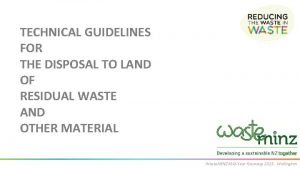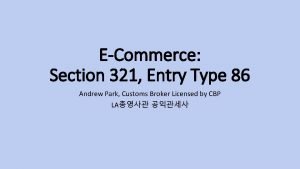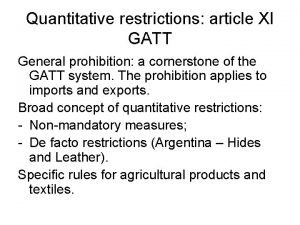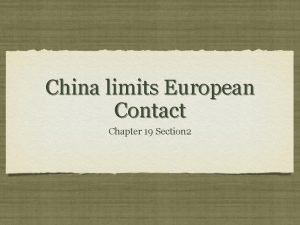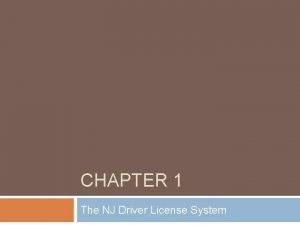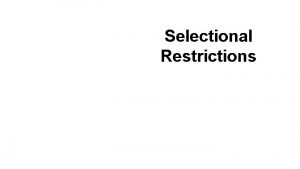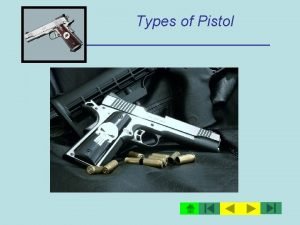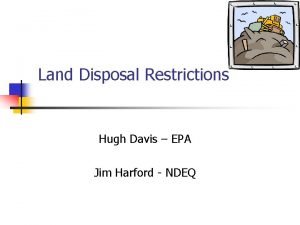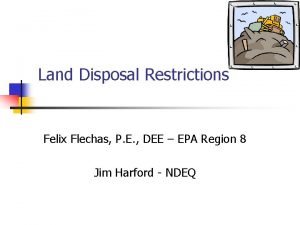CASE STUDY FORMER PISTOL RANGE Land Disposal Restrictions






- Slides: 6

CASE STUDY FORMER PISTOL RANGE Land Disposal Restrictions Management of Remediation Waste Martin E. Sánchez NJDEP

Background • • LSRP was managing the remediation of site EPA ID number acquired for disposal offsite Samples of soil showed TCLP Lead 651 mg/L TCLP Lead Regulatory limit >5 mg/L Disposal vs. Treatment • LSRP subcontracted outfit for excavation, transportation and disposal of Pb contaminated soils • Subcontractor hired Environmental Contractor to treat Pb contaminated soils on-site • Treated soils were sent to Subtitle D landfill as ID 27 for land disposal

Inspection Findings ■ LSRP indicated that the soils excavated and treated on a concrete pad. The treatment reagent (slurry) Maectite was poured on to the mound of soil and mixed using a back hoe. ■ The treated soils were sampled and tested prior to shipment offsite. ■ Subtitle D landfill indicated that the TCLP Pb of the treated soils received for land disposal were 1. 1 mg/L. The treatment standard in 0. 75 mg/L. ■ No records of compliance to Land Disposal Restriction requirements were noted.

Notice of Violation Issued Ø 40 CFR 268. 7(a)(3) Failure to send, in its initial shipment, a one-time written notice to Subtitle D landfill that the waste excavated soil sent complies with the treatment standards specified in 40 CFR part 268 subpart D Ø 40 CFR 268. 7(a)(5) Failure to develop and follow a written waste analysis plan which describes the procedures they will carry out to comply with the treatment standards specified in 40 CFR part 268 subpart D Ø 40 CFR 270. 10(e-f) Failure to submit a Part A / Part B permit application to the Department prior to treating (chemical stabilization) Lead contaminated soil (D 008 hazardous waste) on a paved floor (un-containerized) Ø 40 CFR 268. 9(c) Failure to determine that the Waste Lead contaminated soil was above treatment standards for Lead prior to being land disposed.

LSRP Response to the NOV ■ Treatment was performed in-situ within the Area of Contamination (AOC) ■ LSRP cited US EPA Memo 10/24/98 as the basis for contesting the violations. https: //yosemite. epa. gov/OSW/rcra. nsf/ea 6 e 50 dc 6214725285256 bf 0006 3269 d/D 9 E 61 A 0505 DB 4 B 6885256817006 E 32 B 8/$file/14291. pdf “Area of Contamination Policy. In what is typically referred to as the area of contamination (AOC) policy, EPA interprets RCRA to allow certain discrete areas of generally dispersed contamination to be considered RCRA units (usually landfills). Because an AOC is equated to a RCRA land-based unit, consolidation and in situ treatment of hazardous waste within the AOC do not create a new point of hazardous waste generation for purposes of RCRA. This interpretation allows wastes to be consolidated or treated in situ within an AOC without triggering land disposal restrictions or minimum technology requirements. ” § The Department disagreed with this interpretation.

Overview on Management of RCRA Soils https: //archive. epa. gov/epawaste/hazard/web/pdf/mrw_slides. pdf ■ US EPA defines in situ “in its original place, ” or on-site”, means unexcavated and unmoved. ■ Department position: Ø Pb soils were treated ex-situ in a pile (un-containerized) Ø AOC policy does not apply in this case. The treated soils were disposed off-site and NOT managed within the AOC. Ø Treated soils did NOT meet treatment standards prior to Land Disposal
